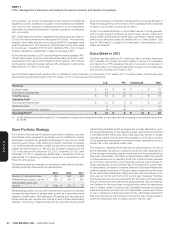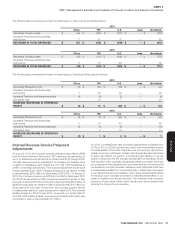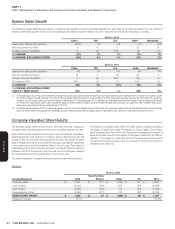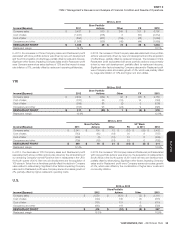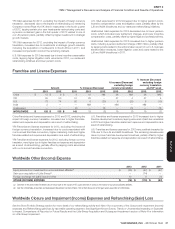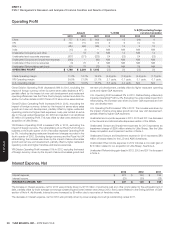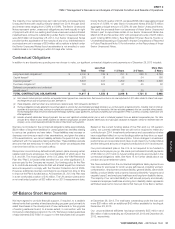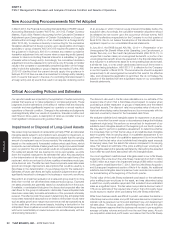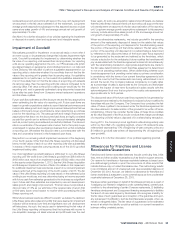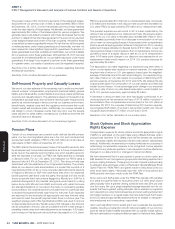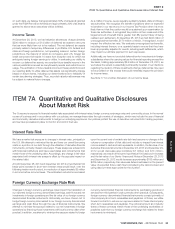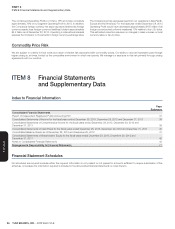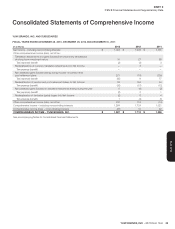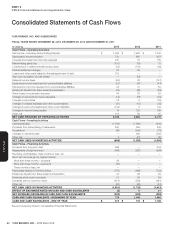Pizza Hut 2013 Annual Report Download - page 126
Download and view the complete annual report
Please find page 126 of the 2013 Pizza Hut annual report below. You can navigate through the pages in the report by either clicking on the pages listed below, or by using the keyword search tool below to find specific information within the annual report.
YUM! BRANDS, INC.-2013 Form10-K30
Form 10-K
PART II
ITEM7Management’s Discussion and Analysis of Financial Condition and Results of Operations
Net cash used in financing activities was $1,451 million in 2013
compared to $1,716 million in 2012. The decrease was primarily driven by
lower net debt payments and lower share repurchases in 2013, partially
offset by higher dividends paid on common stock and lower tax benefits
from share-based compensation.
In 2012, net cash used in financing activities was $1,716 million compared
to $1,413 million in 2011. The increase was driven by increased share
repurchases.
Consolidated Financial Condition
The changes in our Goodwill and Intangible assets, net are primarily the result of the partial impairment of Little Sheep’s goodwill and trademark. See
the Little Sheep Acquisition and Subsequent Impairment section of Note 4.
The changes in our Other liabilities and deferred credits and Accumulated other comprehensive income (loss) are primarily the result of actuarial gains
in our U.S. pension plans recognized in 2013. See Note 14.
Liquidity and Capital Resources
Operating in the QSR industry allows us to generate substantial cash
flows from the operations of our Company-owned stores and from our
extensive franchise operations which require a limited YUM investment�
Net cash provided by operating activities has exceeded $1 billion in each
of the last twelve fiscal years, including over $2 billion in 2013, 2012 and
2011. We expect these levels of net cash provided by operating activities
to continue in the foreseeable future. However, unforeseen downturns in
our business could adversely impact our cash flows from operations from
the levels historically realized�
In the event our cash flows are negatively impacted by business downturns,
we believe we have the ability to temporarily reduce our discretionary
spending without significant impact to our long-term business prospects.
Our discretionary spending includes capital spending for new restaurants,
acquisitions of restaurants from franchisees, repurchases of shares of our
Common Stock and dividends paid to our shareholders. As of December28,
2013 we had approximately $1.2 billion in unused capacity under our
revolving credit facility that expires in March 2017.
China and YRI represented approximately 70% of the Company’s segment
operating profit in 2013 and both generate a significant amount of positive cash
flows that we have historically used to fund our international development. To
the extent we have needed to repatriate international cash to fund our U.S.
discretionary cash spending, including share repurchases, dividends and
debt repayments, we have historically been able to do so in a tax-efficient
manner. If we experience an unforeseen decrease in our cash flows from
our U.S. business or are unable to refinance future U.S. debt maturities we
may be required to repatriate future international earnings at tax rates higher
than we have historically experienced.
We currently have investment-grade ratings from Standard & Poor’s Rating
Services (BBB) and Moody’s Investors Service (Baa3). While we do not
anticipate a downgrade in our credit rating, a downgrade would increase
the Company’s current borrowing costs and could impact the Company’s
ability to access the credit markets cost-effectively if necessary. Based on
the amount and composition of our debt at December 28, 2013, which
included no borrowings outstanding under our revolving credit facility, our
interest expense would not materially increase on a full-year basis should
we receive a one-level downgrade in our ratings.
Discretionary Spending
During 2013, we invested $1,049 million in capital spending, including
$568 million in China, $289 million in YRI, $161 million in the U.S. and
$31 million in India. For 2014, we estimate capital spending will be
approximately $1.2 billion.
During the year ended December 28, 2013 we repurchased shares for
$750million, which excluded the effect of $20 million in shares repurchased
with trade dates prior to the 2012 fiscal year end but cash settlement dates
subsequent to the 2012 fiscal year. On November 16, 2012 our Board of
Directors authorized share repurchases through May 2014 of up to $1 billion
(excluding applicable transaction fees) of our outstanding Common Stock.
On November 22, 2013, our Board of Directors authorized additional share
repurchases through May 2015 of up to $750 million (excluding applicable
transaction fees) of our outstanding Common Stock. At December 28,
2013, we had remaining capacity to repurchase up to $953 million of
outstanding Common Stock (excluding applicable transaction fees) under
these authorizations. Shares are repurchased opportunistically as part of
our regular capital structure decisions.
During the year ended December 28, 2013, we paid cash dividends of
$615 million. Additionally, on November 22, 2013 our Board of Directors
approved cash dividends of $0.37 per share of Common Stock that were
distributed on February 7, 2014 to shareholders of record at the close of
business on January 17, 2014. The Company targets an ongoing annual
dividend payout ratio of 35% to 40% of net income.
Borrowing Capacity
Our primary bank credit agreement comprises a $1.3 billion syndicated
senior unsecured revolving credit facility (the “Credit Facility”) which matures
in March 2017 and includes 24 participating banks with commitments
ranging from $23 million to $115 million. We believe the syndication reduces
our dependency on any one bank.
Under the terms of the Credit Facility, we may borrow up to the maximum
borrowing limit, less outstanding letters of credit or banker’s acceptances,
where applicable. At December 28, 2013, our unused Credit Facility totaled
$1.2 billion net of outstanding letters of credit of $65 million. There were no
borrowings outstanding under the Credit Facility at December 28, 2013.
The interest rate for most borrowings under the Credit Facility ranges
from 1.0% to 1.75% over the “London Interbank Offered Rate” (“LIBOR”).
The exact spread over LIBOR under the Credit Facility depends upon our
performance against specified financial criteria. Interest on any outstanding
borrowings under the Credit Facility is payable at least quarterly.
The Credit Facility is unconditionally guaranteed by our principal domestic
subsidiaries. This agreement contains financial covenants relating to
maintenance of leverage and fixed-charge coverage ratios and also
contains affirmative and negative covenants including, among other things,
limitationson certain additional indebtedness and liens, and certain other
transactions specified in the agreement. Given the Company’s strong
balance sheet and cash flows we were able to comply with all debt
covenant requirements at December 28, 2013 with a considerable amount
of cushion. Additionally, the Credit Facility contains cross-default provisions
whereby our failure to make any payment on our indebtedness in a principal
amount in excess of $125 million, or the acceleration of the maturity of
any such indebtedness, will constitute a default under such agreement.


